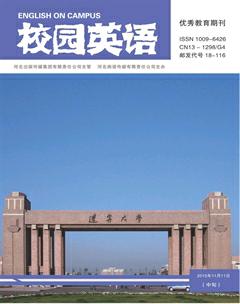“Faithfulness” in Literature Translation vs “Faithfulness”in WTO Text Translation
2015-12-07汪珉
汪珉
【Abstract】Faithfulness, as a criterion of translation, is not only suitable for literature translation, but also for WTO text translation. However, there are some apparent differences between the two. The writer will make a comparative study between them.
【Key words】Faithfulness; literature translation; WTO text translation
Translation is the process of the information transmission and information reproduction. In the translation of literary works, translators could choose different words or phrases to express the same meaning. However, such artifice is banned in WTO text translation because consistency is a “golden principle” in the process of drafting legal documents like WTO texts. The translation of WTO texts should avoid those artifices as subaudition, implication, connotation and explication, etc. which are rather important in literature translation. Take one of Byrons poems and its Chinese version for example (cited in Wu Cunmin, 1997):
Original poem:My days are in the yellow leaf;
The flowers and fruit of love are done;
The worm, the canker, and the grief are mine alone!
Li Peien, a famous translator, metaphrased it into following Chinese version:
年華黄叶秋,花实空悠悠; 多情徒自苦,残泪带愁流。
In the Chinese version,“My days” is translated as “年华”and “are done” is translated into “空悠悠”. We cant find the counterparts of the word “love” and the verse “The worm, the canker, and the grief are mine alone!” in the in the version, while there are no corresponding verses in the original poem to “多情徒自苦,残泪带愁流。”. On the first face Mr. Lis paraphrase, which is more like the scholar-bureaucrats poets, is not faithful to the original, but he applied a free translation approach to paraphrase the true essence of the Byrons original poem and the writer holds that Lis paraphrase is faithful to the Byrons original meaning as a literature translation. However, in WTO text translation, such paraphrases are banned, or they will be considered unfaithful. For example:
The English original text: The representative of China said that China had a territory of 9.6 million square kilometres and, at the end of 1998 a population of 1.25 billion. Since 1979, China had been progressively reforming its economic system, with the objective of establishing and improving the socialist market economy. The reform package introduced in 1994, covering the banking, finance, taxation, investment, foreign exchange (“forex”) and foreign trade sectors, had brought about major breakthroughs in China's socialist market economy. (Report of the Working Party on the Accession of China, par. 6)
The Chinese version: 中国代表表示,中国拥有960万平方公里的国土面积,
1998年年末全国总人口为12.5亿。自1979年以来,中国以建立和完善社会主义市场经济为目标,逐步改革经济体制。1994年采取的一揽子改革措施涵盖银行、金融、税收、投资、外汇(“forex”)和对外贸易等部门,使中国的社会卞义市场经济取得了重大突破。
The version involves metaphrase. There is no need to use “幅員辽阔” here to modify the large area, or “人口众多” to modify the large number of population, because the purpose of WTO text translation is to state the meaning of the original text correctly and clearly. In the writers view, “涵盖” is faithful to the English original text. Some ordinary words are endowed with special meaning in WTO texts: “package”originally means a wrapped or boxed object; a parcel or a container in which something is packed for storage or transportation, but here it means a proposition or an offer composed of several items, each of which must be accepted. So“The reform package” is translated into “一揽子改革措施”, which now becomes a popular phrase in the Chinas economic realm.
Comprehending the original text is the precondition and foundation of the translation, and translators should ravel the sentence structure completely.
Here is another example: The English original text: A new tax and financial system was functioning effectively. Financial policy had been separated from commercial operations of the central bank, which now focused on financial regulation and supervision. (Report of the Working Party on the Accession of China, par.6)
The Chinese version: 用新的财税体制有效运行。中央银行的政策性金融和商业金融己经分开,目前的重点在于调控和监管。
Here “which” refers to “financial policy”, the logic subject of the non-restrictive clauses. The version is a little confusing in this aspect. In addition, The term of “financial policy” should be rendered into “金融政策” rather than “政策性金融”, and “of the central bank” is used to modify “commercial operations” rather than “financial policy”. Therefore, the writer offers the following suggested version:新的财税制度正有效地运转。金融政策已与央行的商业运转分离,目前重点放在金融调控与监管。
It is more faithful to the original than the first one.
Through the comparison, we can draw a conclusion that “Faithfulness” is an important criterion to both literature translation and WTO text translation, although there are some different requirements in detail between the two kinds of translations.
参考文献:
[1]外经贸部组织翻译.中国入世议定书[M].人民出版社出版,2001.
[2]吴存民.论信达雅的有机完整性--兼评译论中的一种错误倾向[J].中国翻译,1997.
